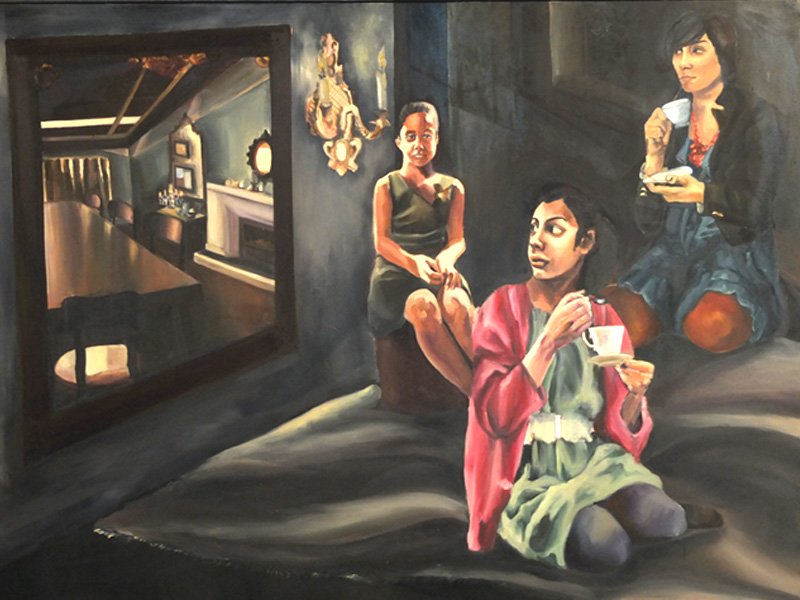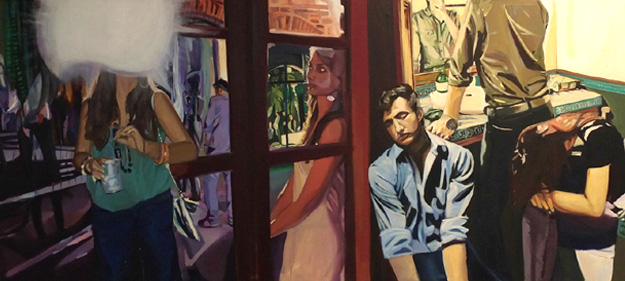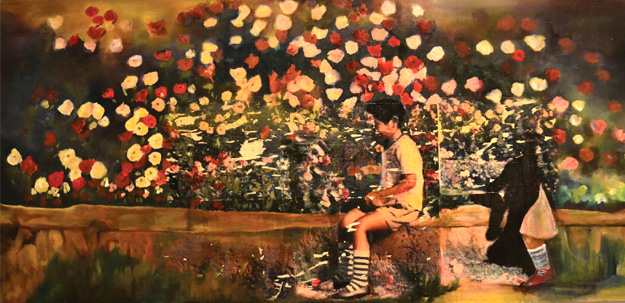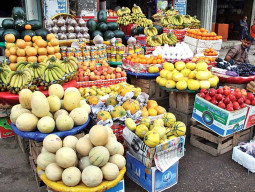
“My work celebrates artificiality and being plastic. At the same time, too much of anything can be painful. So there is beauty and yet there is repulsion,” says Minaa Mohsin whose massive canvases with bold striking colours hit you as you enter Zahoorul Ikhlaq Gallery which houses part of the National College of Arts thesis work by undergraduates.
Mohsin’s work includes self portraits. The artist is seen watching television with a friend, washing her feet in a bathroom stocked with products and being pulled in all direction in a beauty parlour. “My work is about excessive patterns and how things can represent you,” says Mohsin. She says she appears in the pieces as the work is about appearances. She has not priced her work as “it was not on my mind.”
Shah Abdullah’s work is about self sufficiency. “Every person has the ability to solve their own problems.” Abdullah, who grew up in Quetta, says he has painted the body as a tool for self expression. “My pieces have injured men in them. What is more important? Healing the wound or gouging it further to make it worse?” He points to a work which depicts a semi clad man in the sky. “The body leaves but your spiritual life remains. Our clothes and body are like brands. Actions, attitudes and personality are left behind.” Abdullah’s prices range from Rs70,000 to Rs120,000.

Lahore-born Naira Mushtaq sold out her entire thesis on the first day. Pricing her work at Rs20,000 per piece, Mushtaq says she just wanted to sell so she could start working on new ideas.
She has worked with family photographs for her thesis. “I worked with the idea of violence inherent in the ordinary. I don’t mean gore or social and political violence; it’s this passive-aggressive, quiet kind of violence.” She says that people often consciously ignore but subconsciously internalise hostile actions directed towards them and sometimes it’s just one small thing that makes them snap.
“As time passes, these vernacular photos get faded and blots appear on them. To me, these images appear violent.”

Mushtaq insists that even though her jury went fine, she is not in line for honours.
Later in the afternoon, her name makes it to the honours list.
“It is a basic human need … not to be alone. When you are born you have your parents and you are always trying to fill the vacuum. My work is about power, sensations and intimacy,” says Haider Ali Akmal speaking about his charcoal drawings and a series of aquatints. He says his work is a visual representation of a manuscript he wrote about a character’s search for intimacy and connection. His work is priced between Rs15,000 to Rs40,000.
Amna Manzoor started her work from painting Adam and Eve. “They were conditioned not to do something yet they did it. I have used ropes to depict their restriction.” In Manzoor’s work threads and ropes are unraveling. “I started looking at how femininity is constructed and how I was conditioned. To stitch, to keep long hair, to wear shalwar kameez.” Manzoor is already signed up for a show in Jordan and one at Ijaz Gallery. The miniature artist has priced her work between Rs40,000 and Rs55,000.
Yasir Waqar has explored the idea of outside influences shaping ones’ life. He says his work looks at how the young are instilled with ideas. “There is respect and gratitude towards elders as they mean well but at the same time it is suffocating. There is a clash between your own genius and a super ego.”

Waqar is a Quetta resident who says he trained as a pilot as his father desired. “But I did not enjoy it and turned to painting. Some people can visualise success only in certain fields. If a metal wing can fly then so can a natural wing,” he says about one of his miniatures. “Success can come in any field. Things that are forced on you never work out.” His work is priced from Rs40,000 and up.
Sarah Imran’s work also looks at the way society impacts a person’s sense of self both socially and culturally. “Fear is transmitted to us socially by deeming things right or wrong. Decisions are made … and grounds … paved for us to walk on.” Her work is a large narrative, on eight canvases that are all joined together and take up an entire wall. “It’s individually broken into my own fairy tales.”
Imran says her jury gave her both positive and negative feedback. “They thought my work was courageous.” She hopes to put out a book of stories on her canvases. “Her pieces are priced between Rs40,000 and Rs60,000.
Print maker Saad Ahmed has looked at acts that would be considered strange in public but could be ignored after passage of time. “If you are confident, then it is acceptable. Any display of nervousness gives others the opportunity to criticise you.” Ahmed says he decided to use etchings as he wanted to revive the art. His work ranges from Rs20,000 to Rs30,000.
“I was fortunate that my jury got the poetic under-layer of my work. They understood why I used Morris wallpaper,” said Rajab Ali Syed. He points to one of his pieces and said, “The jury understood that the flash covering my friends face was a harkening to the Byzantine era where a halo was seen behind the head of a saint. The divine becomes the debauched, obliterating energy of our times.”

Syed says his work is set in the now. “It is a juxtaposition of the modern lifestyle with an older decadent time. We are smoking, drinking, putting chemicals in our bodies because we want to feel something greater than ourselves. This is not a criticism, rather a romantic view of how we are living. We will find meaning wherever we see it,” he says of a piece which shows a group of young people in varying postures at a party. His work is ranged from Rs35,000 to Rs55,000.
Shabbir Ahmed’s thesis work , Nothing is Funnier Than Unhappiness, deals with social issues in Balochistan. The Dera Maula Jamali resident says, “All my paintings are self portraits in that they are my comment on how I feel. When you are helpless, all you can do is laugh.” Ahmed’s work ranges from Rs30,000 to Rs100,000.
The display is up till January 27.
Published in The Express Tribune, January 20th, 2013.


1725443747-0/Untitled-design-(5)1725443747-0-165x106.webp)


1731666526-0/Express-Tribune-(9)1731666526-0-270x192.webp)
1731648084-0/Untitled-design-(57)1731648084-0-270x192.webp)










COMMENTS
Comments are moderated and generally will be posted if they are on-topic and not abusive.
For more information, please see our Comments FAQ